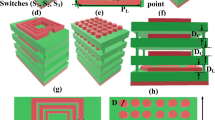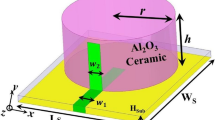Abstract
This work proposes a novel dielectric resonator antenna design for 5G-based IoT applications that operates in the sub-6 GHz frequency range. The DR antenna is built on a 1.6-mm-thick FR-4 substrate with dimensions of 30*50 mm2. The proposed dielectric resonator antenna is made of alumina and is excited using a microstrip feedline of 50 Ω. Because of the hybrid arrangement of cylindrical and rectangular dielectric resonator elements on the FR4 substrate, this proposed structure has improved the radiation mechanism. The antenna design process begins with creating the antenna in the Ansys HFSS EM simulator, which is then optimized using machine learning based on the antenna geometry’s target factors. A data set of 2625 sample data values is generated in HFSS and fed to various machine learning algorithms for further optimization based on data trends. Post-optimization, the antenna design is fabricated and tested. The proposed antenna offers a wide bandwidth of 1.1 GHz between 3.5 and 4.6 GHz and resonates at 3.9 GHz making it suitable for 5G sub-6 GHz IoT applications.





Similar content being viewed by others
References
Khashimov, A.B.: Mathematical modeling of complex antenna system, In 2016 2nd International Conference on Industrial Engineering, Applications and Manufacturing (ICIEAM), (2016), pp. 1–4. https://doi.org/10.1109/ICIEAM.2016.7911680.
Aghababaiyan, K.; Kebriaei, H.; Mansouri, V.S.; Maham, B.; Niyato, D.: Enhanced modulation for multiuser molecular communication in internet of nano things. IEEE Internet Things J 9, 19787–19802 (2022)
Kulkarni, J.; Kulkarni, N.; Sim, C.-Y.-D.; Desai, A. A two-port dual band microstrip feed based cylindrical dielectric resonator antenna array for sub-6 GHz 5G and super extended-C band applications, In 2021 International Conference on Communication information and Computing Technology (ICCICT), (2021), pp. 1–5. https://doi.org/10.1109/ICCICT50803.2021.9510136.
Gangwar, R.K.; Ranjan, P.; Aigal, A.: Wideband four-element two-segment triangular dielectric resonator antenna with monopole-like radiation. Int. J. Microw. Wirel. Technol. 9(2), 411–418 (2017). https://doi.org/10.1017/S1759078715001622
Hussain, R.: Shared-aperture slot-based sub-6-GHz and mm-wave IoT antenna for 5G applications. IEEE Internet Things J. 8(13), 10807–10814 (2021). https://doi.org/10.1109/JIOT.2021.3050383
Chattha, H.T.; Ishfaq, M.K.; Khawaja, B.A.; Sharif, A.; Sheriff, N.: Compact multiport MIMO antenna system for 5G IoT and cellular handheld applications. IEEE Antennas Wirel. Propag. Lett. 20(11), 2136–2140 (2021). https://doi.org/10.1109/LAWP.2021.3059419
El Misilmani, H.M. and Naous, T.: Machine learning in antenna design: an overview on machine learning concept and algorithms, In 2019 International Conference on High Performance Computing & Simulation (HPCS), pp. 600–607. (2019) https://doi.org/10.1109/HPCS48598.2019.9188224.
Srivastava, A.; Gupta, H.; Gupta, A. K.; Penmatsa, K.K.V.; Ranjan P.; Sharma A.: Aperture coupled dielectric resonator antenna optimisation using machine learning techniques AEU-Int J Electron Commun, 154, (2022)
Liu, B.; Aliakbarian, H.; Ma, Z.; Vandenbosch, G.A.E.; Gielen, G.; Excell, P.: An efficient method for antenna design optimization based on evolutionary computation and machine learning techniques. IEEE Trans. Antennas Propag. 62(1), 7–18 (2014). https://doi.org/10.1109/TAP.2013.2283605
Wu, Q.; Wang, H.; Hong, W.: Multistage collaborative machine learning and its application to antenna modeling and optimization. IEEE Trans. Antennas Propag. 68(5), 3397–3409 (2020). https://doi.org/10.1109/TAP.2019.2963570
Sharma, Y.; Zhang, H.H.; Xin, H.: Machine learning techniques for optimizing design of double T-shaped monopole antenna. IEEE Trans. Antennas Propag. 68(7), 5658–5663 (2020). https://doi.org/10.1109/TAP.2020.2966051
Akdag, I.; Gocen, C.; Palandoken, M.; Kaya, A.: Estimation of the scattering parameter at the resonance frequency of the UHF band of the E-shaped RFID antenna using machine learning techniques, In 2020 4th International Symposium on Multidisciplinary Studies and Innovative Technologies (ISMSIT), (2020), pp. 1–5. https://doi.org/10.1109/ISMSIT50672.2020.9254362.
Sharma, A.; Das, G.; Ranjan, P.; Sahu, N.K.; Gangwar, R.K.: Novel feeding mechanism to stimulate triple radiating modes in cylindrical dielectric resonator antenna. IEEE Access 4, 9987–9992 (2016). https://doi.org/10.1109/ACCESS.2016.2633361
Balanis, C.A.: Antenna Theory: Analysis and Design, 4th Editio. John Wiley and Sons, USA (2016)
Sharma, A.; Gangwar, R.K.: Hybrid two segments ring dielectric resonator antenna for ultrawideband application. Int. J. RF Comput. Aided Eng. 26, 47–53 (2016)
Xiao, L.-Y.; Shao, W.; Jin, F.-L.; Wang, B.-Z.; Liu, Q.H.: Inverse artificial neural network for multiobjective antenna design. IEEE Trans. Antennas Propag. 69(10), 6651–6659 (2021). https://doi.org/10.1109/TAP.2021.3069543
Wu, Q.; Cao, Y.; Wang, H.; Hong, W.: Machine-learning-assisted optimization and its application to antenna designs: opportunities and challenges. China Commun. 17(4), 152–164 (2020). https://doi.org/10.23919/JCC.2020.04.014
Cui, L.; Zhang, Y.; Zhang, R.; Liu, Q.H.: A modified efficient KNN method for antenna optimization and design. IEEE Trans. Antennas Propag. 68(10), 6858–6866 (2020). https://doi.org/10.1109/TAP.2020.3001743
Xue, M.; Shi, D.; He, Y.; Li, C.: A Novel Intelligent Antenna Synthesis System Using Hybrid Machine Learning Algorithms, In 2019 International Symposium on Electromagnetic Compatibility - EMC EUROPE, Sep. 2019, pp. 902–907. https://doi.org/10.1109/EMCEurope.2019.8871996.
Douglas, B.D.W.; Micah, G.; Zhi Hao, J.: Handbook of Antenna Technologies. (2015).
Sharawi M.S.: Printed MIMO antenna engineering. Norwood, MA, USA: Artech House; 2014
Funding
This work was supported by SERB New Delhi (Grant No. SRG/2020/000043 dated 27/10/2020).
Author information
Authors and Affiliations
Corresponding author
Rights and permissions
Springer Nature or its licensor (e.g. a society or other partner) holds exclusive rights to this article under a publishing agreement with the author(s) or other rightsholder(s); author self-archiving of the accepted manuscript version of this article is solely governed by the terms of such publishing agreement and applicable law.
About this article
Cite this article
Ranjan, P., Krishnan, A., Dwivedi, A.K. et al. Design and Optimization of MIMO Dielectric Resonator Antenna Using Machine Learning for Sub-6 GHz based on 5G IoT Applications. Arab J Sci Eng 48, 14671–14679 (2023). https://doi.org/10.1007/s13369-023-07830-9
Received:
Accepted:
Published:
Issue Date:
DOI: https://doi.org/10.1007/s13369-023-07830-9




